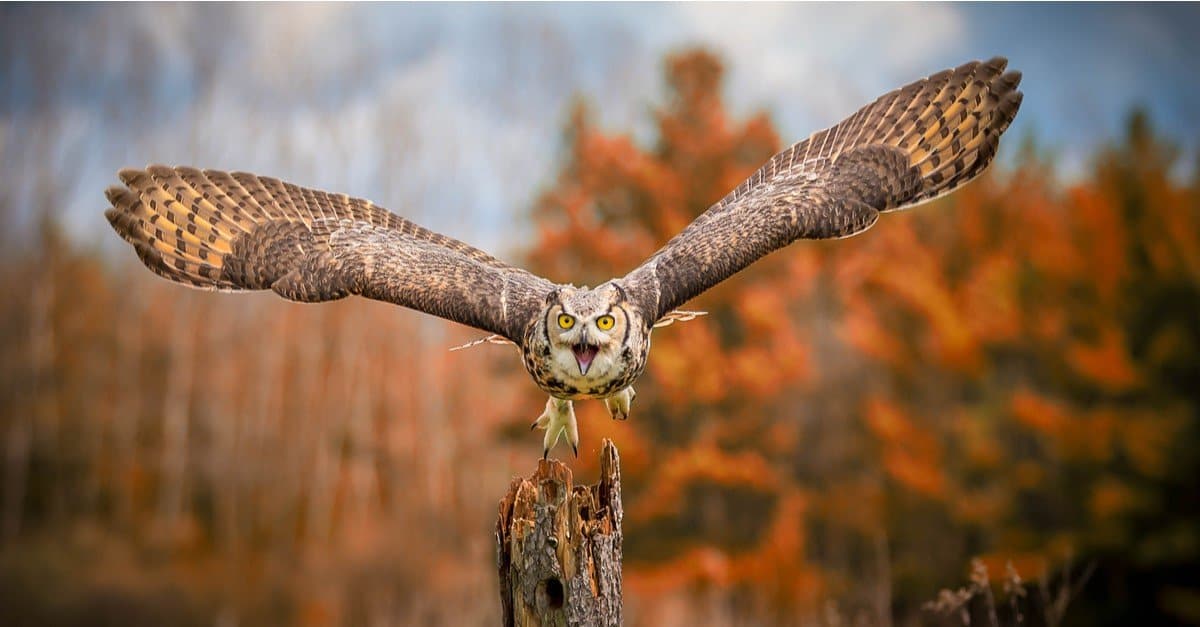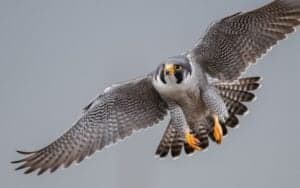Great horned owls (sometimes referred to as tiger owls or hoot owls) are large predatory birds that live across the Americas. They are some of the most geographically diverse owls in the world and come in a variety of colors. They are beautiful birds and are one of the only owls used in falconry. Let’s take a closer look at these owls and learn.
Great Horned Owl Size and Wingspan: How Big Are They?
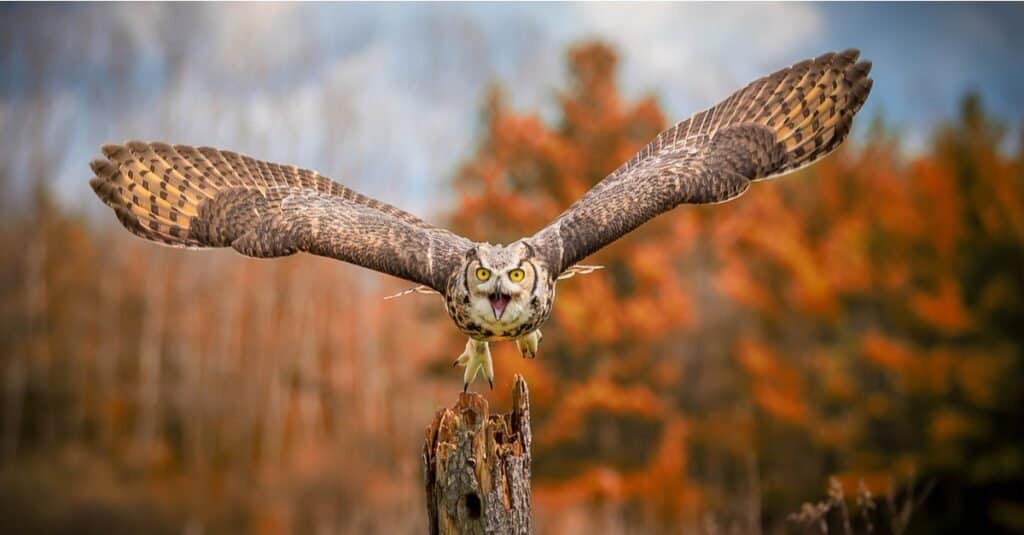
Great horned owls can weigh up to 5.5 lbs and have wingspans that reach up to 4.6 feet.
©Imran Ashraf/Shutterstock.com
On average, great horned owls can grow to over 2 feet tall and weigh up to 3.6 pounds (in females). In some sub-species, they can even weigh up to 5.5 pounds.
When it comes to wingspan, great horned owls measure around 4.6 feet long. Their talons can be up to 3 inches long and can apply up to 300 lb/in2 of force. In short, the great horned owl size makes them powerful and deadly predators.
The great horned owl possesses certain significant characteristics, including eye tubes and uneven ears, which enable them to triangulate sound and locate prey.
Great horned owls are some of the largest true owls across the Americas. They are the heaviest owls in Central and South America and are the second heaviest in North America. They have barrel-shaped bodies and distinctive feather plumes on top of their head, earning them the “horned” name.
When it comes to great horned owl size, there are two contributing factors that make significant differences. Females are larger than males, on average, which is a common occurrence among birds of prey. Secondly, regional differences contribute to size discrepancies. The largest owls live in interior Alaska and Ontario, and the populations in Texas and California are the smallest in the US.
Which Owl has the Largest Wingspan?
Great horned owls are the largest owls in Central and South America, but they don’t have the largest wingspan in North America. That honor solidly goes to the snowy owl. Snowy owls often have wingspans that reach up to 5 feet and weigh up to 4.5 pounds.
These beautiful owls are known for their stark white plumage, a perfect adaptation to their snowy environments. They primarily live in the far northern ranges of Canada, well up into the tundra.
Although the snowy owl is the largest in the Americas, they aren’t the largest in the world. The largest owl in the world is the Blakiston fish owl. The Blakiston fish owl has a 6-foot wingspan and can weigh up to 8.8 pounds.
They are incredibly endangered, likely with a mere 1,500-3,700 owls remaining in the wild. Their range is across north-eastern Asia, primarily China, Japan, and eastern Russia. They are able to grow so large due to their specialized diet of fish, mainly salmon.
Where Do Great Horned Owls Live?
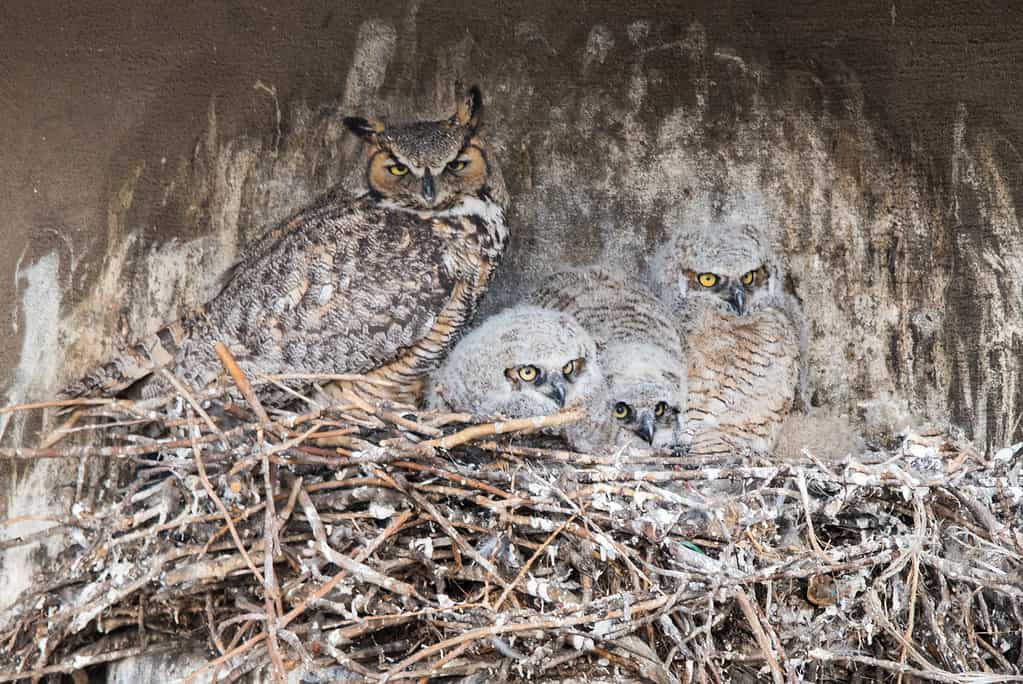
Three juvenile Great Horned Owls perched in a nest under the watchful eye of their mother
©iStock.com/Bobliving
Great horned owls are some of the most widespread owls in the world. They range as far north as Canada and Alaska, where they grow to the largest of any other region’s subspecies.
Heading south, they live through most of the United States, all the way from California to Virginia, covering the continental states. In Central America, they primarily live in Mexico, Guatemala, El Salvador, and Honduras.
In South America, they live along the northern coast of French Guyana, Guyana, Suriname, and through Venezuela and Columbia. Their southern range then starts in northern Bolivia and continues south into Paraguay and through Brazil and Argentina.
How Fast Can an Owl Fly?
On average, a great horned owl is able to fly at speeds of up to 40 mph. When they aren’t fleeing or hunting, however, they generally stick to speeds of about half that, around 25 mph.
This makes these birds some of the fastest flyers in the owl family. Since owls generally rely on stealth, not speed, to catch their prey, they don’t need to be as fast as a hawk or eagle.
Of all the owls in the world, the great horned owl is likely the fastest, with a current clocked speed of 40 mph.
Are Owls Really Silent Flyers?
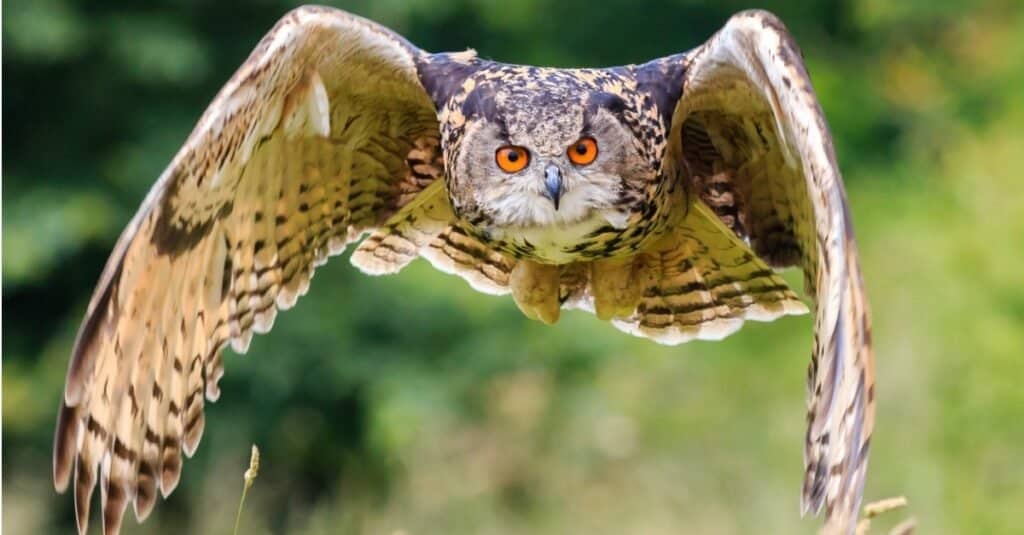
Owls have specially adapted wings that allow them to silently fly as slow as 2 mph.
©Richard Whitcombe/Shutterstock.com
There is a common belief that owls are silent flyers, and in this case, the beliefs are true! Most species of owl have this capability, allowing them to drop down on prey with barely a whisper. There are a few things that allow them to fly silently.
Their wing structure has serrations on the leading edge of their feathers, essentially acting as disruptors for wind, so there isn’t “whooshing” when they fly quickly. They also have softer feathers that help to deaden any noise, as well as a trailing fringe of feathers that act as further sound disruption.
An additional benefit that owls have when flying is their ability to fly at incredibly low speeds. Their specific wing structure allows a great horned owl to fly as slow as 2 mph on a breeze. The slow-flying tactic can help them silently approach prey with incredible success.
Other Facts About the Great Horned Owl
Owls are some of the best hunters in the animal kingdom. One amazing detail is that they have some of the largest proportional eyes of any terrestrial vertebrate on Earth.
This allows them to see tiny bits of motion, even when nocturnally hunting. Additionally, their ears are asymmetrical. This asymmetry allows for better triangulation of sound when listening for prey that isn’t visible.
The ear holes are located at different heights and help them identify the direction and distance better than two symmetrically placed ears. This adaptation is especially helpful when hunting rodents and small mammals in the snow or under leaf cover.
Like other owl species, they can’t move their eyes and instead, move their entire head. A great horned owl can state their head 270 degrees when looking for prey.
Thank you for reading! Have some feedback for us? Contact the AZ Animals editorial team.

